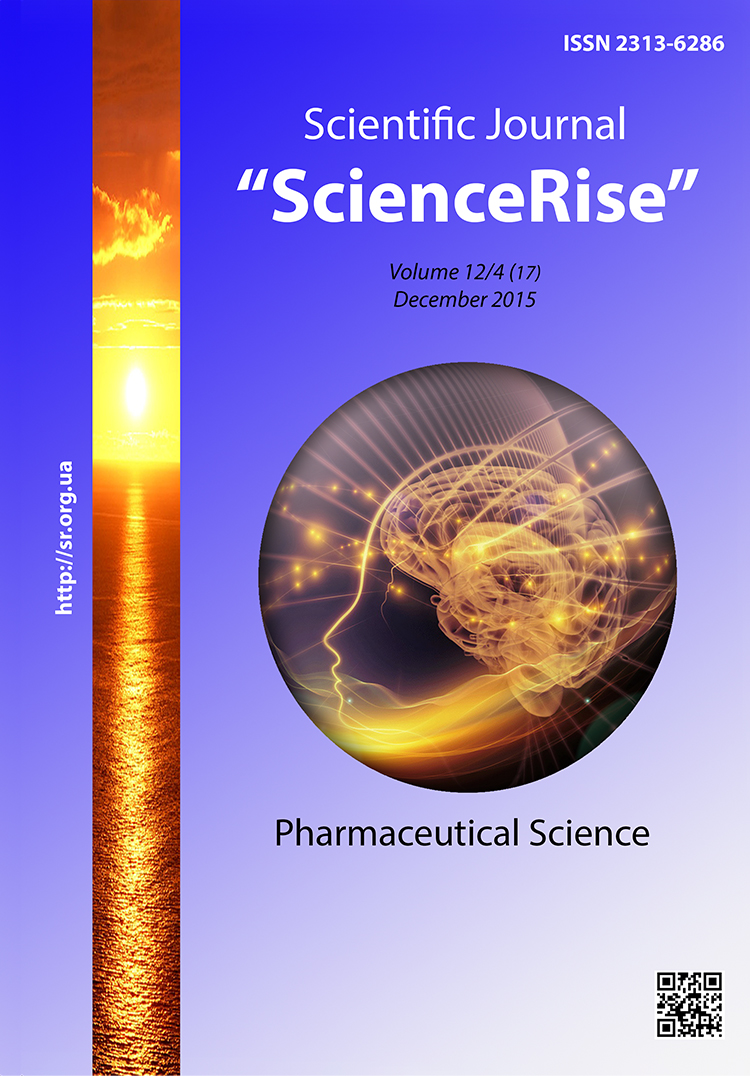Risk identification for quality on stage of pharmaceutical development of combined eye drops for glaucoma treatment
DOI:
https://doi.org/10.15587/2313-8416.2015.56944Keywords:
drug, pharmaceutical development, QbD, critical quality attribute, risk assessment, CH Q9Abstract
Aim: To identify the possible risks associated with critical quality attribute of combined eye drops for the treatment of glaucoma using of common risk evaluation methodologies for plannig a drug quality on the stage of pharmaceutical development.
Methods: The paper used method of causal analysis. The maximal number of factors has been define to identify potential factors that provide most significant impact on the drug quality and Ishikawa diagram - graphical representation of causes and effects has been built.
Results: Analysis allowed to organize the possible factors affecting the drug quality in the generalized categories: quality control methods, medicines and excipients, primary packaging, proper manufacturing conditions and the stage of the process. The most important factors that are carriers of the risk factors and may lead to negative effects have been identified for the generalized categories.
Conclusions: Determined at the stage of pharmaceutical development potential critical quality attribute of AFI, excipients and primary packaging, critical parameters of the process, provide a better understanding, reduction and adoption of risk in subsequent stages of the life cycle of the drug
References
EMEA/CHMP/167068/2004 Pharmaceutical Development (ICH Q8) (2011). Ministry of Health of Ukraine, 42.
EMA/INS/GMP/79766/2011 Quality Risk Management (ICH Q9) (2011). Ministry of Health of Ukraine, 30.
EMA/INS/GMP/79818/2011 Pharmaceutical Quality System (ICH Q10) (2011). Ministry of Health of Ukraine, 30.
Development and Manufacture of Drag Substances (Chemical Entities and Biotechnological/Biological Entities) Q11 (2012). ICH Harmonised Tripartite Guideline, 26. Available at: http://www.ich.org/fileadmin/Public_Web_Site/ICH_Products/Guidelines/Quality/Q11/Q11_Step_4.pdf
Pharmaceutical CGMPs for the 21st Century: A Risk-Based Approach; A Science and Risk-Based Approach to Product Quality Regulation Incorporating an Integrated Quality Systems Approach, United States Department of Health and Human Services (2002). U.S. Food and Drug Administration. Available at: http://www.fda.gov/Drugs/DevelopmentApprovalProcess/Manufacturing/QuestionsandAnswersonCurrentGoodManufacturingPracticescGMPforDrugs/ucm137175.htm
Guidance for Industry PAT – A Framework for Innovative Pharmaceutical Development, Manufacturing, and Quality Assurance (2004). U.S. Department of Health and Human Services, 19. Available at: http://www.fda.gov/downloads/Drugs/GuidanceComplianceRegulatoryInformation/Guidances/UCM070305.pdf
Mollah, A. H., Longs, M., Bejsmen, G. S. (2014). Risk management in pharmaceutical manufacturing. Moscow: VIALEK Group, 472.
Giher, Z. А. (2010). Practicheskij opyt primenenija sistemi upravlenija riskami v OAO «InterChim» [Practical experience in the application of risk management systems at InterChem SLC]. Pharmacevticheskaja otrasl, 1, 30–33. Available at: http://archive.promoboz.com/n1_18/30-33.pdf
Lebedinets, V. A., Kovalenko, S. N. (2011). Estimation, analysis and management of quality risks at the pharmaceutical enterprise. Management, economy and quality assurance in pharmacy, 6, 10–15.
Shestopal, O. A. (2010). Optimization of quality system components at a pharmaceutical enterprise by application of risk management. Kharkiv, 20.
Kashutsky, S. N., Rusanova, S. V., Dihtyaryov, S. I. (2013). Realization of general estimation of risks for quality and optimization composition of pills tunicate on the stage of pharmaceutical development. Pharmacom, 3, 54–62.
Kashutsky, S. N., Rusanova, S. V., Dihtyaryov et. al (2014). Vyjavlenie riskov dlja kachestva processa proizvodstva lekarstvenogo sredstva v forme tabletok na etapi farmacivticheskoj razrabotki [Identification risks for quality of manufacturing process of a medicament in tablet form at stage of pharmaceutical development]. Vladikavkaz, 106–109.
Kashutsky, S. N., Rusanova, S. V., Dihtyaryov, S. I. et. al (2014). Identificacja riskov dlja kachestva v processi proizvodstva tabletok na etapi farmacivticheskoj razrabotki [Risk identification for quality at manufacturing process of tablets on stage of pharmaceutical development]. Vladikavkaz, 110–112.
Kashutsky, S. N., Rusanova, S. V., Dihtyaryov, S. I. et. al (2015). Some aspects of risk management for the quality of processes of production of the medicine «fenspiride hydrochloride, coated tablets by 0,08 gr» at the stage of pharmaceutical development. Chemical-Pharmaceutical Journal, 11, 49–53.
Andryukova, L. M., Fetisova, Е. G., Yakubchuk, O. M. et. al (2013). Identification of critical quality attribute for eye drops medicinal form. Management, economy and quality assurance in pharmacy, 6, 4–9.
Andryukova, L. M., Yakubchuk, O. M., Fetisova, Е. G. et. al (2014). Common risk evaluation of quality at the stage of pharmaceutical development of eye drops dosage form. Management, economy and quality assurance in pharmacy, 2, 4–7.
Yakubchuk, O. M., Andryukova, L. M., Fetisova, Е. G. et. al (2014). Application of risk assessment in justifying the choice of excipients in the composition of eye drops with antiglaucoma actions. Management, economy and quality assurance in pharmacy, 5, 11–15.
Derzhavna Farmakopeja Ukrai'ny (2004). Kharkiv: OOO Ryreg, 520.
Downloads
Published
Issue
Section
License
Copyright (c) 2015 Олександр Миколайович Якубчук, Світлана Володимировна Русанова, Олена Геннадіївна Фетісова, Лариса Миколаївна Андрюкова, Володимир Костянтинович Яковенко

This work is licensed under a Creative Commons Attribution 4.0 International License.
Our journal abides by the Creative Commons CC BY copyright rights and permissions for open access journals.
Authors, who are published in this journal, agree to the following conditions:
1. The authors reserve the right to authorship of the work and pass the first publication right of this work to the journal under the terms of a Creative Commons CC BY, which allows others to freely distribute the published research with the obligatory reference to the authors of the original work and the first publication of the work in this journal.
2. The authors have the right to conclude separate supplement agreements that relate to non-exclusive work distribution in the form in which it has been published by the journal (for example, to upload the work to the online storage of the journal or publish it as part of a monograph), provided that the reference to the first publication of the work in this journal is included.

